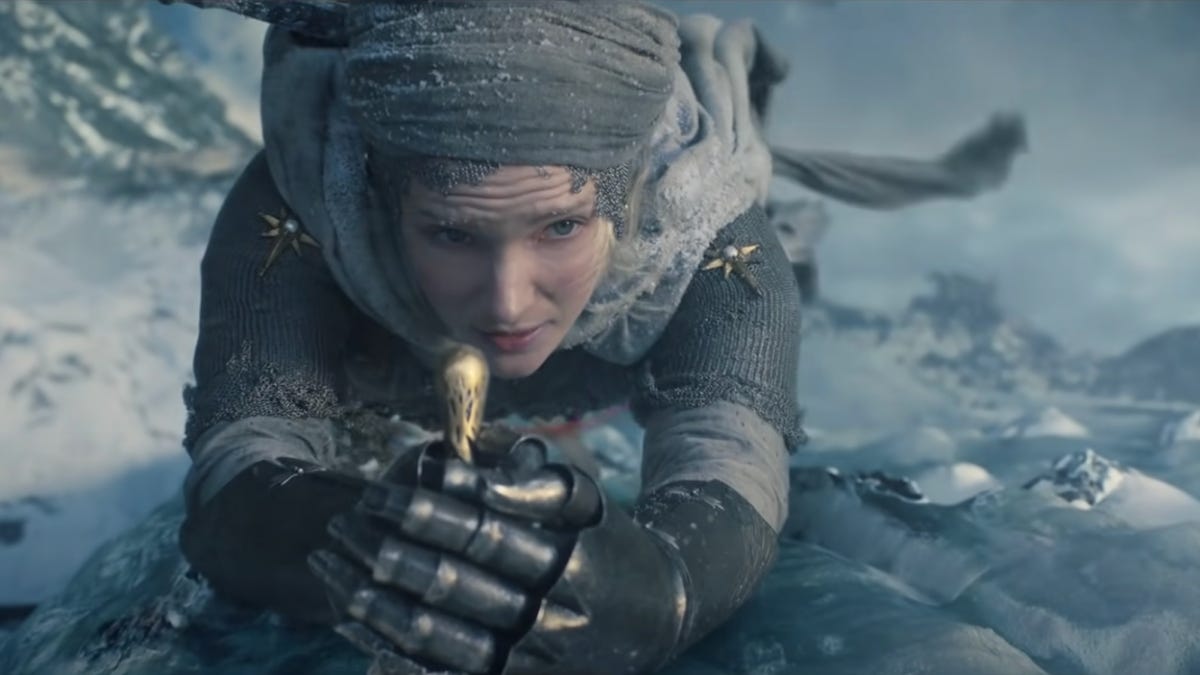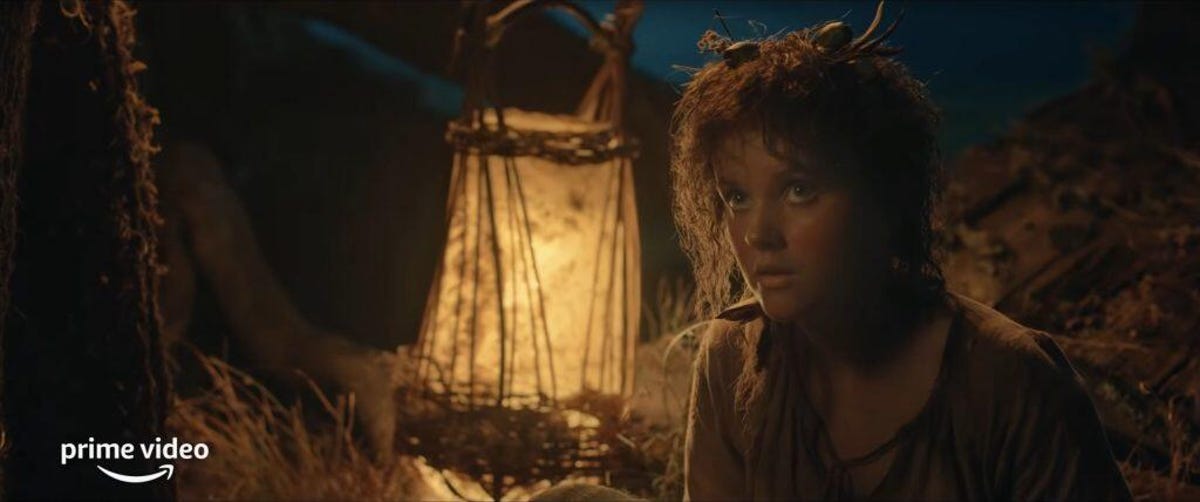
Amazon’s new TV series The Rings of Power is a bit controversial for some. There are vocal groups concerned showrunners J.D. Payne and Patrick McKay won’t make every effort to ensure this show is in line with J.R.R. Tolkien’s collected works and may add things Tolkien wouldn’t approve of. For many Tolkien fans, this is a song we’ve heard before. There have been doubts cast on every modern Tolkien story brought to screen, including Peter Jackson’s The Lord of the Rings movies.
While every episode of The Rings of Power is going to have a recap article courtesy of CNET’s own Erin Carson, this article will be dedicated entirely to the analysis of how well each episode sticks to what Tolkien wrote.
To be clear, this analysis doesn’t include:
- Whether people of color should be on screen as dwarves, elves or Harfoots (they should, end of conversation).
- Whether dwarven women should have full beards (Tolkien was never clear on this, so I won’t be taking a position).
- Whether Tolkien is OK with people inventing things in his world (this letter from Tolkien to his publisher in 1951 makes his position clear).
Episode 1: Shadow of the Past

Galadriel in the new Amazon Series Rings of Power.
Amazon
This episode broadly introduces the world, and a handful of the separate stories seemingly destined to intersect. Check out our full recap for more.
Finrod Felegund’s Dagger
In our opening scene, young Galadriel’s beautiful boat is destroyed, and her big brother stops her from beating the guilty party within an inch of his life for being such a tool. This scene is the first time we see Finrod’s dagger, which Galadriel takes as her own while she seeks out the enemy responsible for his death.
This dagger is beautiful, but there’s no evidence of it having existed in any of Tolkien’s work. Canonically, we know Finrod had a sword and a bow. But we also know he was nobility, and in the few pieces of pre-Rings of Power art we have of Finrod he’s got some beautiful nonstandard jewelry and weaponry on him, including the Ring of Barahir, which eventually finds its way to Aragorn’s hand. The dagger isn’t something Tolkien wrote, but it’s also plausible he’d have a dagger like this.
It’s clearly a representation of Telperion and Laurelin, the twin trees of Valinor, which created sunlight and moonlight for the world before they were destroyed and their last remaining fruit and flower were turned into the sun and moon for Middle-earth. There appear to be three similar spheres on the dagger, in between the silver and gold trees, which would almost certainly be a representation of the three Silmarils. Finrod was a major part of the conflicts surrounding the destruction of the trees and the Oath of Feanor, so having a symbol of those events on him is totally plausible.
Where things get a little fuzzy is Finrod having that dagger in the initial scene with Galadriel. According to Tolkien, Galadriel was born around 90 years before the creation of the Silmarils. Elves physically mature in the first 100 years of their existence, and then age far, far slower after that. At age 90, Galadriel would have looked at least a few years older than what’s shown on screen.
Is this a big deal? Not at all. Do I still want one of those daggers? Absolutely.
Crossing the Sundering Seas
There’s nothing technically wrong about this scene. The elves left Valinor to wage a thousand years of war across much of Middle-earth, which led to Morgoth being stopped and Sauron going into a sort of hiding.
But my goodness did this scene leave a lot out. There could’ve been an entire season of this show dedicated to just that handful of sentences, recapping how the elves found themselves in Middle-earth. If you’re curious, read the ninth chapter of the Quenta Silmarillion titled Of the Fight of the Ñoldor.
The village of Tirharad
If the name of this village didn’t sound familiar to you, you weren’t alone. Tolkien didn’t create Tirharad, but he didn’t create anything in this area that would later become Mordor. We know there were men living in what was then called the Southlands, because Tolkien wrote of how Shelob would prey upon men and elves before Sauron claimed the land as Mordor.
The name Tirharad is a mashup of “watch” and “south” in Sindarin, which makes some sense given the way the village is essentially policed by the Silvan elves from their watchtower. This episode lays out how the descendants of men who served Morgoth settled in the surrounding area, and the elves keep a close eye on them out of concern that corruption may once again enter their hearts. We know that some men did serve Morgoth, whose fortress Udûn existed in the northeast part of the area that later became Mordor, so it isn’t a stretch that men would’ve settled here after the wars.
Galadriel’s return to Valinor
It’s long been suspected that Galadriel was either banned from returning to Valinor or didn’t believe she deserved to return to Valinor, due largely to this line in Galadriel’s Song of Eldamar:
What ship would bear me ever back across so wide a Sea?
This scene shows Galadriel being rewarded (sort of) with the ability to return home, along with the rest of her company. Though Tolkien did write that some elves were permitted to return home after the War of Wrath, it was never explicitly stated that Galadriel was among them. It was written that many high elves opted to remain in Middle-earth even as more of their kind returned home, and Galadriel’s activities at this time aren’t well documented, so this new story is filling in those gaps with new adventures of sorts.
Episode 2: Adrift

One of the Harfoots, a race seen in The Rings of Power and ancestors to Hobbits.
Amazon Prime Video
With a pair of mischievous Harfoots trying to care for The Stranger, Galadriel trying to swim across the Sundering Sea only to find several ways that can go wrong, Tirharad experiencing a pest control issue and Prince Durin having an axe to grind with Elrond, this is a busy episode. Check out the full recap here, and the lore analysis below.
Nori’s not-so-hot foot
It’s easy to hear Nori say the fire isn’t hot and immediately think of Frodo’s reaction to the One Ring as it came from the fireplace to his hand, but the two almost certainly aren’t related. Throughout Tolkien’s works, there aren’t mentions anywhere of magic fire that isn’t hot, but there’s a lot about the character known only as The Stranger that doesn’t quite line up yet.
This scene has further rumors that The Stranger is a wizard, and that fire is actually the Flame of Anor or light of the Sun. For now, it’s unclear how this character and his powers fit into what we know of Middle-earth.
The Rite of Sigin-tarâg
Not a ton is known about what dwarves get up to in their halls under the mountains, because they don’t often invite people in who aren’t of their kin. The few exceptions in the Second Age are largely elves who worked closely with dwarven smiths to create a ton of different things, which we might get to see in this show but not in this episode. So, though Tolkien never wrote about Elrond claiming the Rite of Sigin-tarâg, there’s a ton of empty space when it comes to knowing what dwarves did in private.
Sigin-tarâg doesn’t refer to some kind of competition. The word translates to longbeards, which is the other name for Durin’s folk or this particular kind of dwarf. In this context, the Rite of Sigin-tarâg is exactly as Durin explains it, a test of endurance his people created to settle internal disputes. It’s not something we’ve ever seen before, and not something we’d ever see in the Third Age because of what happens to Durin’s folk, so it’s plausible a challenge like this would exist.
Disa’s resonance
As this isn’t a character created by Tolkien, there’s no record of the special way she helps dwarven miners do their thing. Dwarven women were kept from battle, and as a result aren’t really mentioned much at all in Tolkien’s works. But we do know that dwarves were said to be the best mining folk in the world because they were created with that purpose in mind.
Tolkien never really expands on what specific abilities the dwarves have when it comes to mining, only that Aulë taught them special skills while creating the seven original dwarf lords.
Orcs under the floorboards
There are many examples of Orcs tunneling in Middle-earth, and those tunnels typically lead to what Tolkien called Orc-holds. Some of these Orc-holds were small, like the ones seen in this episode, while others occupied entire mountains, like those seen in Mount Gundabad, which Orcs hold for most of the Second Age.
We know Tirharad isn’t a place Tolkien created, but its proximity to what would soon become Mordor makes it a perfect place for Orcs to be digging under.
